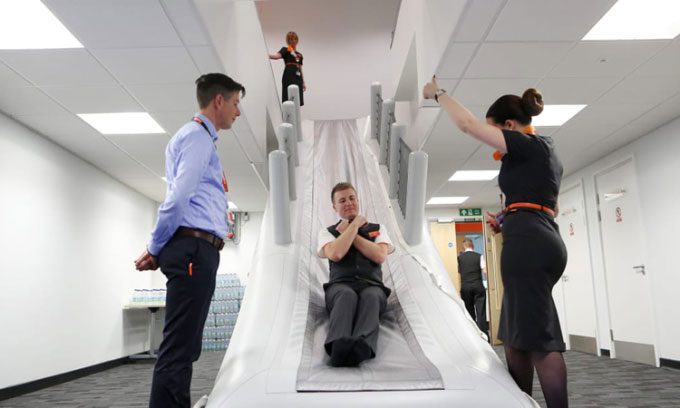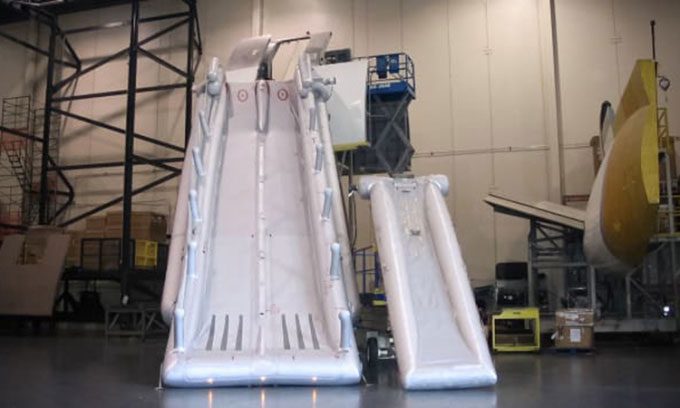Emergency escape slides were invented decades ago, designed to deploy in emergency situations, allowing passengers to safely slide down from the aircraft door.
In emergency situations on the ground, inflatable slides can be deployed from the aircraft door, enabling passengers to escape quickly and safely. This technology emerged at the beginning of the jet age in the 1950s, but it has roots in much simpler escape solutions.

Staff conducting emergency evacuation training with aircraft slides during the opening of EasyJet’s training facility at London Gatwick Airport in 2015. (Photo: Chris Ratcliffe/Bloomberg).
The first passenger aircraft were equipped with tail wheels and typically had doors near the tail, low to the ground. Passengers could simply climb a few steps and then proceed to their seats. The passenger cabin was angled upward, followed by the cockpit. If the captain called for an evacuation, passengers could exit through the main door.
As commercial aircraft grew larger, the tailwheel design became impractical for transporting more passengers and cargo. At that point, aircraft with nose wheels were introduced, with cabins parallel to the ground, but passengers had to climb a long staircase to reach the higher exit door. In emergencies, they could not safely jump directly from the cabin to the ground. Therefore, experts developed a rudimentary solution.
“The first evacuation method for aircraft involved using rope with knots to help people down from the door. This method predated slides by a long time. Later, they devised a way to use a flat piece of fabric stretched between two arms. It needed to be held in place for people to slide down,” said Tony Pope, Chief Engineer for evacuation systems at Collins Aerospace (USA).
Those simple fabric slides have evolved into the sophisticated inflatable slides we see today, inflated by compact pneumatic cylinders. However, knotted ropes still remain in the cockpit, ready for pilots to use if they need to escape through a window or emergency door.
Collins Aerospace and its predecessor Goodrich have designed and manufactured inflatable slides for decades, starting with the Boeing 747 in the 1960s, also known as the “Queen of the Skies.” According to Pope, while materials and manufacturing techniques have gradually improved since the first slides were introduced, the basic design of today’s slides has not changed much.
Emergency escape slides are safety devices on aircraft. (Video: Collins Aerospace)
When designing slides, experts carefully consider the process of folding them into the aircraft – a process similar to packing a parachute. The Federal Aviation Administration (FAA) has also developed a set of regulations for slides, which have evolved over time based on emergency slide deployments.
The regulations cover all aspects of design, such as durability, flammability, and heat resistance of the fabric, as well as the maximum inflation time (ranging from 6 to 10 seconds) depending on the slide’s location. It must deploy correctly in all weather conditions, from -40°C to 70°C, in rain with precipitation up to 2.5 cm per hour, and withstand winds of 46 km/h hitting the slide at a 45-degree angle around the aircraft. Passenger aircraft with doors higher than 1.8 meters above the ground must be equipped with slides, and long-haul jets typically have both slides and integrated life rafts.
The shape of the aircraft directly influences the design of the slides. Each slide is usually unique to its position. “Sometimes we can use the same type of slide for multiple doors, but that’s not the norm,” Pope stated.
The two-deck Airbus A380 poses a significant challenge with a total of 16 slides, eight on each deck. Designers must ensure that they operate “in harmony,” with the slides on the upper and lower decks not obstructing each other. The limited space for slide placement is also a critical consideration.

An emergency slide for the Airbus A380 (left) and a slide designed for the Boeing 737. (Photo: Collins Aerospace)
When working with aircraft manufacturers, Collins Aerospace must demonstrate that all passengers and crew can evacuate the aircraft in 90 seconds or less.
“We have an evacuation speed test, which requires us to prove that the slides can safely evacuate people under various conditions, such as with a high doorway, a low doorway, or in dark conditions,” Pope explained.
Like many aviation technologies related to safety, passengers rarely see emergency escape slides, but they can save lives when needed. This also motivates the experts at Collins Aerospace, Pope shared.
“I love what I do – making safety equipment. We don’t want to see it used and hate the situation that requires it. But when we see it work and show everyone in the team, they realize that what they do is truly important. That gives us all a sense of pride,” he shared.





















































